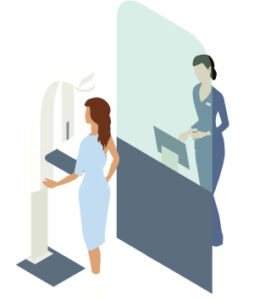 Mammograms are x-rays of the breast tissue that look for signs of breast cancer. They are non-invasive screenings that, per the American Cancer Society, women age 45-54 (without a family history or without the BRCA gene mutation) should receive annually. Women age 55 and older can switch to a mammogram every other year or continue with annual mammograms. Women at high risk for breast cancer, such as those with a first-degree family history of breast cancer; those with the BRCA gene mutation; those who have had radiation therapy to their chest before the age of 30; or who those who have had Li-Fraumeni Syndrome, Cowden Syndrome, or Bannayan-Riley-Ruvalcaba Syndrome, or have first-degree relatives with one of these syndromes; should get a breast MRI and mammogram annually beginning at age 30.
Mammograms are x-rays of the breast tissue that look for signs of breast cancer. They are non-invasive screenings that, per the American Cancer Society, women age 45-54 (without a family history or without the BRCA gene mutation) should receive annually. Women age 55 and older can switch to a mammogram every other year or continue with annual mammograms. Women at high risk for breast cancer, such as those with a first-degree family history of breast cancer; those with the BRCA gene mutation; those who have had radiation therapy to their chest before the age of 30; or who those who have had Li-Fraumeni Syndrome, Cowden Syndrome, or Bannayan-Riley-Ruvalcaba Syndrome, or have first-degree relatives with one of these syndromes; should get a breast MRI and mammogram annually beginning at age 30.
There are two types of mammograms—screening mammograms and diagnostic mammograms. Screening mammograms are either 3D or 2D, depending on what your testing center offers, and are routine mammograms for those who have no symptoms. A diagnostic mammogram is performed when a routine mammogram reveals suspicious results or a patient is experiencing symptoms. Results from a routine mammogram are typically received in the mail within 30 days while results from a diagnostic mammogram are usually received from the doctor in the same day. A diagnostic mammogram will let you know if a biopsy might be needed.
The EWTF Health Plan allows for annual mammograms for covered participants age 35 and over. This exceeds the American Cancer Society’s recommendations. For more information on EWTF mammogram coverage visit https://www.ewtf.org/health-benefits-spd/your-medical-benefits/#well-woman.
